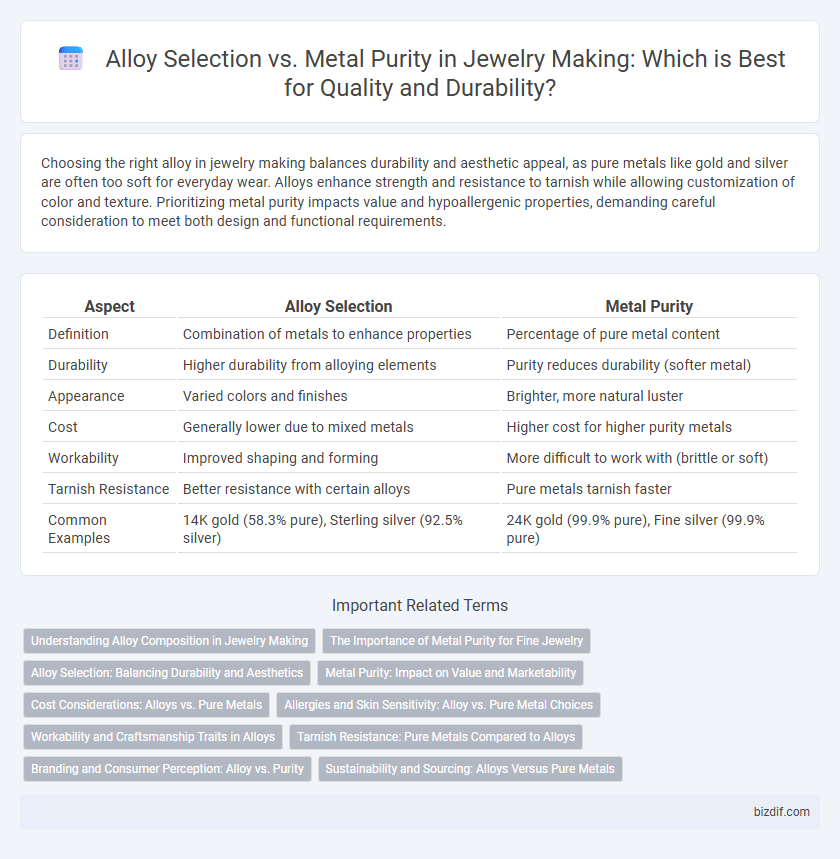Choosing the right alloy in jewelry making balances durability and aesthetic appeal, as pure metals like gold and silver are often too soft for everyday wear. Alloys enhance strength and resistance to tarnish while allowing customization of color and texture. Prioritizing metal purity impacts value and hypoallergenic properties, demanding careful consideration to meet both design and functional requirements.
Table of Comparison
| Aspect | Alloy Selection | Metal Purity |
|---|---|---|
| Definition | Combination of metals to enhance properties | Percentage of pure metal content |
| Durability | Higher durability from alloying elements | Purity reduces durability (softer metal) |
| Appearance | Varied colors and finishes | Brighter, more natural luster |
| Cost | Generally lower due to mixed metals | Higher cost for higher purity metals |
| Workability | Improved shaping and forming | More difficult to work with (brittle or soft) |
| Tarnish Resistance | Better resistance with certain alloys | Pure metals tarnish faster |
| Common Examples | 14K gold (58.3% pure), Sterling silver (92.5% silver) | 24K gold (99.9% pure), Fine silver (99.9% pure) |
Understanding Alloy Composition in Jewelry Making
Understanding alloy composition is crucial in jewelry making because it directly affects the metal's durability, color, and hypoallergenic properties, which are essential for creating high-quality pieces. Selecting alloys like sterling silver (92.5% silver) or 18k gold (75% gold) balances metal purity with strength, ensuring the jewelry maintains both aesthetic appeal and structural integrity. Precise alloy composition also influences melting points and workability, enabling jewelers to choose suitable metals for different crafting techniques.
The Importance of Metal Purity for Fine Jewelry
Metal purity directly influences the durability, color, and value of fine jewelry, with higher purity metals such as 24k gold offering unmatched luster but reduced strength. Jewelers often select alloys--combinations of metals like copper or silver--to enhance hardness and wear resistance while balancing the metal's natural beauty. Understanding the trade-offs between purity and alloy composition is essential for creating pieces that maintain aesthetic appeal and longevity.
Alloy Selection: Balancing Durability and Aesthetics
Alloy selection in jewelry making involves balancing metal purity with enhanced durability and visual appeal. Alloys such as sterling silver (92.5% silver and 7.5% copper) increase strength while maintaining a lustrous finish, making them ideal for everyday wear. Choosing the right alloy composition ensures resistance to tarnish and scratches without compromising the metal's natural beauty.
Metal Purity: Impact on Value and Marketability
Metal purity significantly influences the value and marketability of jewelry, with higher-purity metals like 22K or 24K gold commanding premium prices due to their rarity and appeal. Pure metals offer superior luster and hypoallergenic properties but often lack the durability required for everyday wear, affecting their desirability in certain markets. Balancing purity with alloy addition ensures optimal hardness and aesthetic quality, directly impacting consumer demand and resale value in the jewelry industry.
Cost Considerations: Alloys vs. Pure Metals
Alloy selection in jewelry making often balances cost considerations with desired durability and appearance, as alloys typically cost less than pure metals like gold or platinum due to the inclusion of less expensive metals such as copper or silver. Pure metals possess high purity and intrinsic value but are softer and more expensive, increasing production costs and retail prices. By using alloys, jewelers achieve enhanced strength and affordability, making handcrafted pieces more accessible while maintaining quality aesthetics.
Allergies and Skin Sensitivity: Alloy vs. Pure Metal Choices
Selecting alloys in jewelry making can significantly impact allergy and skin sensitivity risks compared to using pure metals, as alloys often contain nickel or other reactive metals that trigger allergic reactions. Pure metals like 24K gold or fine silver typically offer hypoallergenic properties, reducing the chance of irritation for sensitive skin. Jewelers prioritize metal purity and composition to create pieces that balance durability with wearer comfort, particularly for clients prone to metal allergies.
Workability and Craftsmanship Traits in Alloys
Alloy selection in jewelry making significantly impacts workability and craftsmanship traits, with alloys offering enhanced malleability and durability compared to pure metals. Metals like 18K gold, an alloy mixed with copper and silver, provide superior hardness and resistance to wear while maintaining enough softness for detailed engraving and shaping. This balance allows artisans to achieve intricate designs and long-lasting pieces that pure metals such as 24K gold lack due to their softness and tendency to deform.
Tarnish Resistance: Pure Metals Compared to Alloys
Pure metals like gold and silver offer high metal purity but tend to tarnish more quickly due to their reactivity with environmental elements. Alloys, such as sterling silver (92.5% silver mixed with copper), enhance tarnish resistance by reducing the metal's exposure to reactive impurities and improving durability. Selecting alloys balances aesthetic appeal and longevity, making them ideal for jewelry pieces prone to frequent wear and exposure.
Branding and Consumer Perception: Alloy vs. Purity
Choosing the right alloy in jewelry making significantly influences branding and consumer perception, as alloys can enhance durability and color while maintaining a consistent appearance. High metal purity often appeals to consumers seeking authenticity and luxury, but may compromise strength and longevity. Balancing alloy selection with purity levels allows brands to position their products strategically, combining aesthetic appeal with practical value to meet diverse consumer expectations.
Sustainability and Sourcing: Alloys Versus Pure Metals
Choosing alloys over pure metals in jewelry making often enhances sustainability by enabling the use of recycled and ethically sourced components, reducing the demand for virgin precious metals like 24K gold or 99.9% pure silver. Alloys such as 18K gold and sterling silver maintain durability and aesthetic appeal while allowing for improved resource efficiency and lower environmental impact. The careful selection of responsibly mined or recycled alloys promotes transparency in sourcing and supports circular economy principles within the jewelry industry.
Alloy selection vs Metal purity Infographic

 bizdif.com
bizdif.com